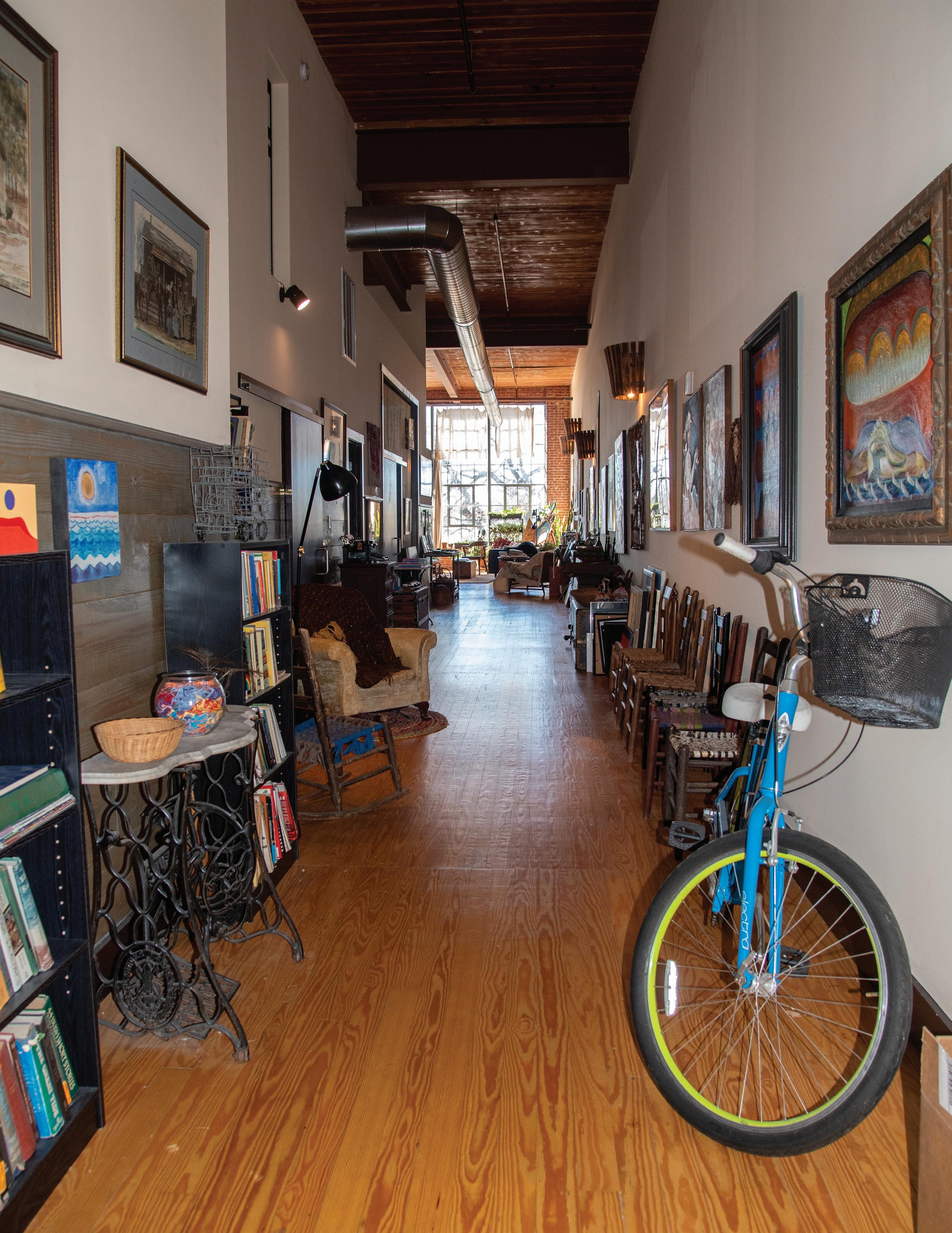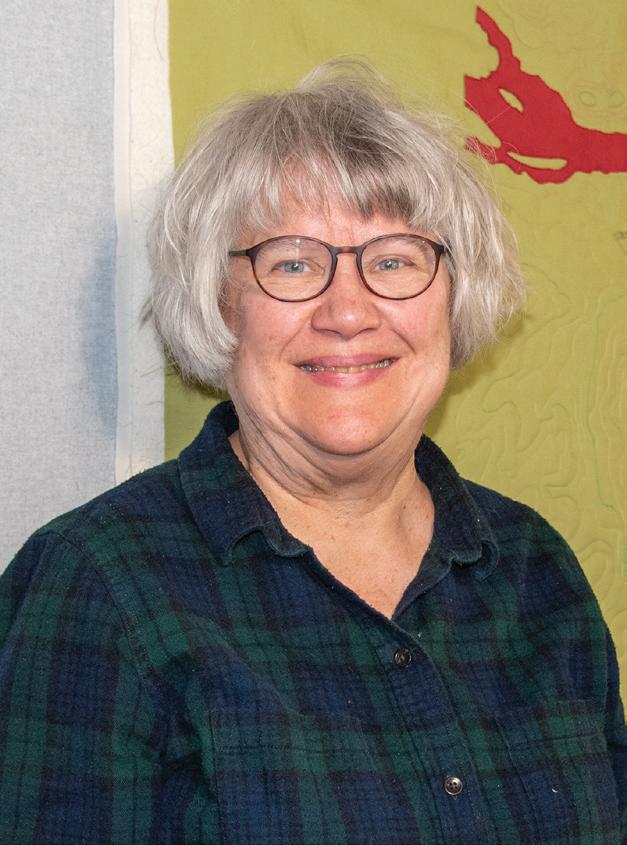
5 minute read
INSPIRED STITCHES
The history of Lake Martin sparks textile artist's creativity
STORY & PHOTOS BY BETSY ILER
Fussell's studio shares living space in a renovated cotton mill in Columbus, Georgia 16 LAKE MARCH 2022
Fussell cut out Lake Martin's many slender sloughs by hand
Cathy Fussell developed an affection for maps as a child. On road trips with her family, her father always put the map in her hand and told her to mind where they were going. Of particular interest to her were the blue ribbons of water that dissected topography shaded in green on the old multi-fold sheets of paper.
She also loved to perch at the end of her mother’s bed and watch her mother sew on a Singer Featherweight machine across the room at the Buena Vista, Georgia, home where she grew up.
“I started sewing when I was about 4 years old,” Fussell said. “To teach me to sew a straight seam, Mama had me practice on the machine without thread, on lined notebook paper, punching holes on the lines on the paper.”
She’s been stitching for more than 55 years now.
When she started quilting, it was only natural that Fussell paired childhood memories in her art projects. She has quilted waterways far and wide across the country, but none has given her quite so many fits as the deeply fingered shorelines of Alabama’s Treasured Lake. She created her first Lake Martin quilt last year.
“I really could have used a laser cutter, but I didn’t have one, so I cut out all those tiny curves,” Fussell
Csaid in only half-mocked exasperation. “All 880 miles of it – by hand.” The 39-inch by 36-inch cotton duck canvas quilt is simple only in its pictorial design. Fussell used just two colors. An almost pale blue light-weight canvas depicts the 31-mile length of Lake Martin from Jaybird Landing to Cherokee Bluffs, and a heavier weight cotton represents the surrounding land area in an even brown tone. The neutral coffee color accentuates the painstakingly accurate many-lobed footprint of Alabama’s Freshwater Coast. Around the lake, Fussell stitched a fantasy quilt pattern that very nearly – but not quite – mirrors the topographical lines on the map she enlarged and printed across a series of 13-inch by 19-inch sheets of paper. She used a lightboard to transfer the map image onto a sheet of appliqué backing, pressed it onto her fabric and began the laborious process of cutting around the lake. The sheets of paper were pinned to a wallsized board mounted in her studio for reference as she worked. Fussell’s studio doubles as a guest room in the renovated cotton mill apartment she shares with her husband, artist Fred Fussell, in Columbus, Georgia. The

old mill complex once included seven buildings next to the train tracks in this historic Southern city, but four of the buildings were lost to fire. The three that remain were converted into artists’ studios and high-end apartments that feature refinished original mill flooring, reclaimed brick walls and high ceilings. Steel-framed panes of glass create the outside wall.
Fred paints colorful modern landscapes in an openconcept great room, the walls of which are lined with the couple’s art. Quilts and canvas co-exist and intermingle in the spectacular natural light that fills the room.
But down a hall bordered with an array of antiques small and large, a sliding barn door harbors Fussell’s work tables, shelves of fabric, rolls of quilt batting and the Juki 2010Q, a simple straight-stitch machine, on which she stitches her wonderful maps.
She finished the Lake Martin canvas several months ago, having not ever actually visited the lake.
“We drive through the area when we visit family in Mississippi, but we’d never stopped,” she admitted.
Fussell’s interest in the area was piqued when she read Casey Cep’s Furious Hours, an investigative account of the Rev. Willie Maxwell, a rural Tallapoosa County preacher who in the 1970s was accused of murdering five members of his family but never was convicted in any of them. Maxwell was assassinated by a relative at the funeral of his last victim. Cep’s story incorporates the research of beloved author, Harper Lee, who had worked on an unpublished book about the crimes. Having learned more about Lake Martin then, Fussell was motivated to render the lake in fabric.
After finishing the Lake Martin quilt, Fussell stopped last month at Horseshoe Bend National Military Park on a return trip through the area. She toured the displays in the visitors center and learned

The Tallapoosa River runs red for the Creek blood that was shed in the 1814 battle
details of the historic 1814 battle in which an estimated 800 to 2,000 Red Stick Creeks were massacred by Gen. Andrew Jackson’s troops. The Indians attempted to escape across the river but were killed by militia waiting on the opposite bank. The pivotal battle changed the course of the nation, as it led to the Creeks ceding of most of the lands in what is now the Southeast U.S.
“I felt so strongly about what happened there that I came home and started working on a Horseshoe Bend quilt the next day,” Fussell explained. “I have never before included politics in a quilt work. Quilting is solace and meditative, but I just felt like I had to do something. It has me thinking about a series of genocide quilts.”
The Horseshoe Bend quilt is an earthy shade of green, and Fussell followed the actual topographical lines to create the quilting pattern. Over the battlefield, she hand-embroidered 1,200 seed stitches to represent the bodies of Indians killed in the massacre. The river was the first element she added to the fabric but not in the lively blues of her previous water quilts. In the Horseshoe Bend quilt, the Tallapoosa River is depicted in bright, rich red.
“It is red to represent the blood of the Creek nation,” she said, her voice edged with emotion. “It just affected me so.” Her research on the subject of the Cathy Fussell Horseshoe Bend quilt included a study of the painting by American artist Roger Brown (1941-1997), which is part of the Roger Brown Study Collection at the School of the Art Institute of Chicago. Given the 40-plus hours Fussell invested in the Lake Martin quilt, which is priced at $1,200, she expects the Horseshoe Bend quilt, being slightly larger, will require more of her time and talent, as well as more of her heart. Fussell will post the completed Horseshoe Bend photo on social media on March 27, the anniversary of the battle, and she expects to create some companion pieces. The quilt will be included in future exhibits. A collection of Fussell’s quilts is on display this month at the public library in Hoover, Alabama. See more of her quilts, pillows and stitched art collections at cathyfussellquilts.com.




